The Cambridge History of Japan, Vol. 4: Early Modern Japan
Подождите немного. Документ загружается.

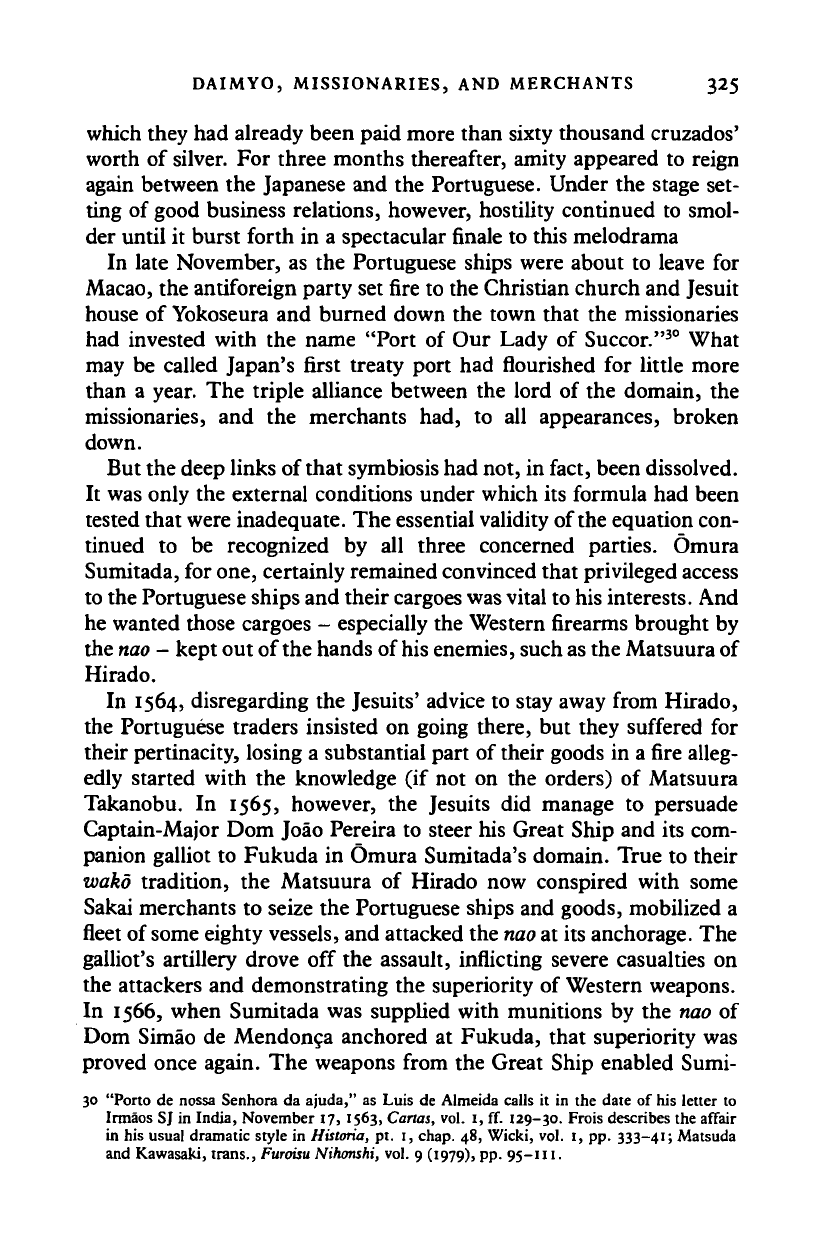
DAIMYO, MISSIONARIES, AND MERCHANTS 325
which they had already been paid more than sixty thousand cruzados'
worth of silver. For three months thereafter, amity appeared to reign
again between the Japanese and the Portuguese. Under the stage set-
ting of good business relations, however, hostility continued to smol-
der until it burst forth in a spectacular finale to this melodrama
In late November, as the Portuguese ships were about to leave for
Macao, the antiforeign party set fire to the Christian church and Jesuit
house of Yokoseura and burned down the town that the missionaries
had invested with the name "Port of Our Lady of Succor."
30
What
may be called Japan's first treaty port had flourished for little more
than a year. The triple alliance between the lord of the domain, the
missionaries, and the merchants had, to all appearances, broken
down.
But the deep links of that symbiosis had not, in fact, been dissolved.
It was only the external conditions under which its formula had been
tested that were inadequate. The essential validity of the equation con-
tinued to be recognized by all three concerned parties. Omura
Sumitada, for one, certainly remained convinced that privileged access
to the Portuguese ships and their cargoes was vital to his interests. And
he wanted those cargoes - especially the Western firearms brought by
the
nao
- kept out of the hands of his enemies, such as the Matsuura of
Hirado.
In 1564, disregarding the Jesuits' advice to stay away from Hirado,
the Portuguese traders insisted on going there, but they suffered for
their pertinacity, losing a substantial part of their goods in a fire alleg-
edly started with the knowledge (if not on the orders) of Matsuura
Takanobu. In 1565, however, the Jesuits did manage to persuade
Captain-Major Dom Joao Pereira to steer his Great Ship and its com-
panion galliot to Fukuda in Omura Sumitada's domain. True to their
wako tradition, the Matsuura of Hirado now conspired with some
Sakai merchants to seize the Portuguese ships and goods, mobilized a
fleet of
some
eighty vessels, and attacked the
nao
at its anchorage. The
galliot's artillery drove off the assault, inflicting severe casualties on
the attackers and demonstrating the superiority of Western weapons.
In 1566, when Sumitada was supplied with munitions by the nao of
Dom Simao de Mendonca anchored at Fukuda, that superiority was
proved once again. The weapons from the Great Ship enabled Sumi-
30 "Porto de nossa Senhora da ajuda," as Luis de Almeida calls it in the date of his letter to
Irmaos SJ in India, November 17, 1563, Cartas, vol. 1, ff. 129-30. Frois describes the affair
in his usual dramatic style in Historia, pt. 1, chap. 48, Wicki, vol. 1, pp. 333-41; Matsuda
and Kawasaki, trans.,
Furcrisu
Nihonshi, vol. 9 (1979), pp. 95-m.
Cambridge Histories Online © Cambridge University Press, 2008
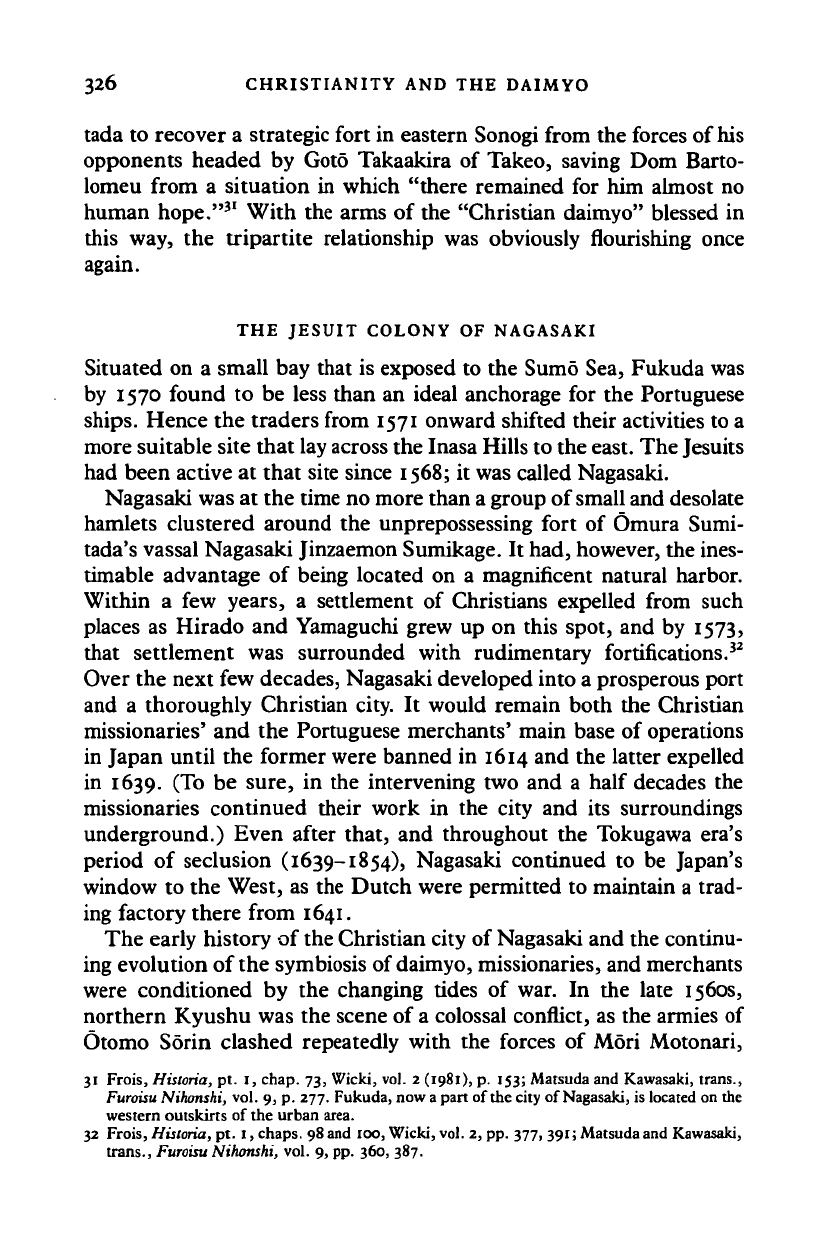
326 CHRISTIANITY AND THE DAIMYO
tada to recover a strategic fort in eastern Sonogi from the forces of his
opponents headed by Goto Takaakira of Takeo, saving Dom Barto-
lomeu from a situation in which "there remained for him almost no
human hope."
31
With the arms of the "Christian daimyo" blessed in
this way, the tripartite relationship was obviously flourishing once
again.
THE JESUIT COLONY OF NAGASAKI
Situated on a small bay that is exposed to the Sumo Sea, Fukuda was
by 1570 found to be less than an ideal anchorage for the Portuguese
ships.
Hence the traders from 1571 onward shifted their activities to a
more suitable site that lay across the Inasa Hills to the east. The Jesuits
had been active at that site since 1568; it was called Nagasaki.
Nagasaki was at the time no more than a group of small and desolate
hamlets clustered around the unprepossessing fort of Omura Sumi-
tada's vassal Nagasaki Jinzaemon Sumikage. It had, however, the ines-
timable advantage of being located on a magnificent natural harbor.
Within a few years, a settlement of Christians expelled from such
places as Hirado and Yamaguchi grew up on this spot, and by 1573,
that settlement was surrounded with rudimentary fortifications.
32
Over the next few decades, Nagasaki developed into a prosperous port
and a thoroughly Christian city. It would remain both the Christian
missionaries' and the Portuguese merchants' main base of operations
in Japan until the former were banned in 1614 and the latter expelled
in 1639. (To be sure, in the intervening two and a half decades the
missionaries continued their work in the city and its surroundings
underground.) Even after that, and throughout the Tokugawa era's
period of seclusion (1639-1854), Nagasaki continued to be Japan's
window to the West, as the Dutch were permitted to maintain a trad-
ing factory there from 1641.
The early history of the Christian city of Nagasaki and the continu-
ing evolution of the symbiosis of
daimyo,
missionaries, and merchants
were conditioned by the changing tides of war. In the late 1560s,
northern Kyushu was the scene of a colossal conflict, as the armies of
Otomo Sorin clashed repeatedly with the forces of Mori Motonari,
31 Frois, Hisioria, pt. I, chap. 73, Wicki, vol. 2 (1981), p. 153; Matsuda and Kawasaki, trans.,
Furoisu
Nihonshi, vol. 9, p. 277. Fukuda, now a part of the city of Nagasaki, is located on the
western outskirts of the urban area.
32 Frois, Hisioria, pt. 1, chaps. 98 and 100, Wicki, vol. 2, pp. 377, 391; Matsuda and Kawasaki,
trans.,
Furoisu Nihonshi, vol. 9, pp. 360, 387.
Cambridge Histories Online © Cambridge University Press, 2008
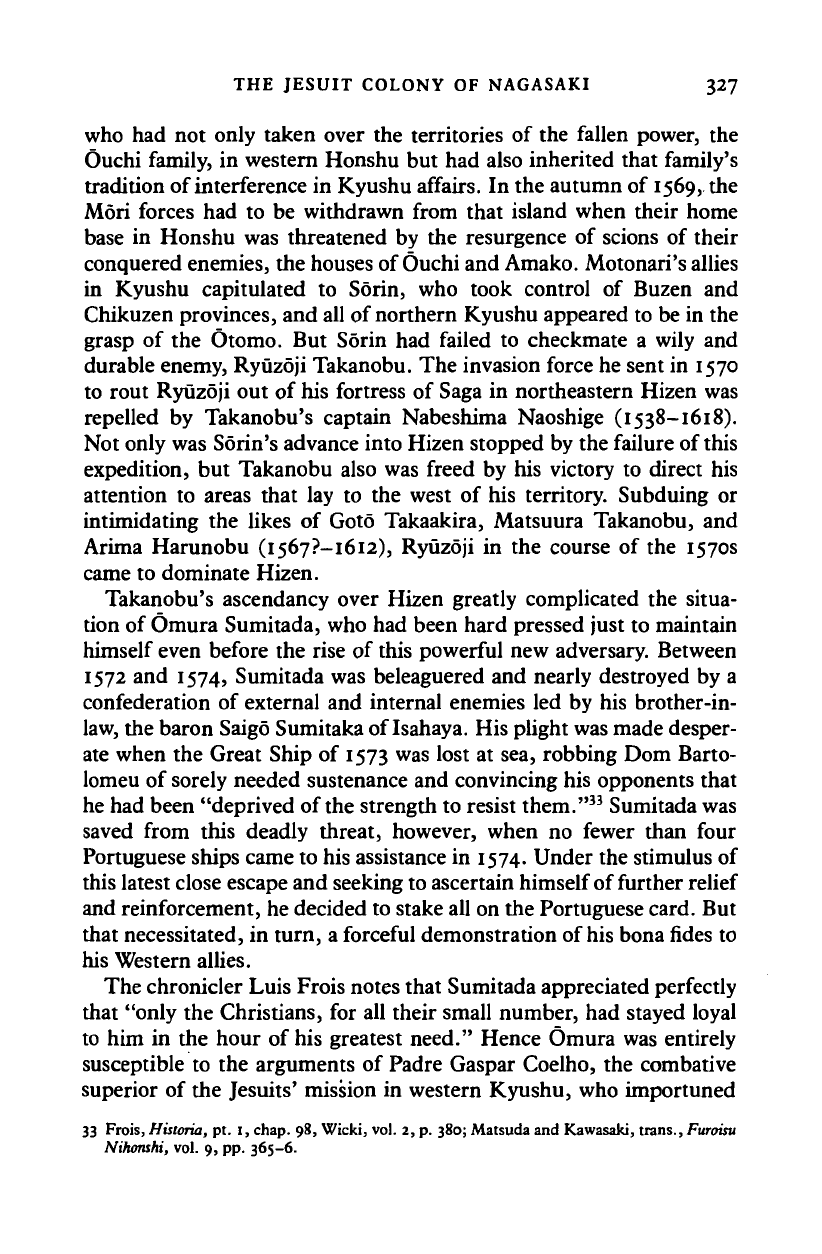
THE JESUIT COLONY OF NAGASAKI 327
who had not only taken over the territories of the fallen power, the
Ouchi family, in western Honshu but had also inherited that family's
tradition of interference in Kyushu affairs. In the autumn of
1569,
the
Mori forces had to be withdrawn from that island when their home
base in Honshu was threatened by the resurgence of scions of their
conquered enemies, the houses of Ouchi and Amako. Motonari's allies
in Kyushu capitulated to Sorin, who took control of Buzen and
Chikuzen provinces, and all of northern Kyushu appeared to be in the
grasp of the Otomo. But Sorin had failed to checkmate a wily and
durable enemy, Ryuzoji Takanobu. The invasion force he sent in 1570
to rout Ryuzoji out of his fortress of Saga in northeastern Hizen was
repelled by Takanobu's captain Nabesbima Naoshige (1538-1618).
Not only was Sorin's advance into Hizen stopped by the failure of this
expedition, but Takanobu also was freed by his victory to direct his
attention to areas that lay to the west of his territory. Subduing or
intimidating the likes of Goto Takaakira, Matsuura Takanobu, and
Arima Harunobu (i567?-i6i2), Ryuzoji in the course of the 1570s
came to dominate Hizen.
Takanobu's ascendancy over Hizen greatly complicated the situa-
tion of Omura Sumitada, who had been hard pressed just to maintain
himself even before the rise of this powerful new adversary. Between
1572 and 1574, Sumitada was beleaguered and nearly destroyed by a
confederation of external and internal enemies led by his brother-in-
law, the baron Saigo Sumitaka of Isahaya. His plight was made desper-
ate when the Great Ship of 1573 was lost at sea, robbing Dom Barto-
lomeu of sorely needed sustenance and convincing his opponents that
he had been "deprived of
the
strength to resist them."
33
Sumitada was
saved from this deadly threat, however, when no fewer than four
Portuguese ships came to his assistance in 1574. Under the stimulus of
this latest close escape and seeking to ascertain himself of further relief
and reinforcement, he decided to stake all on the Portuguese card. But
that necessitated, in turn, a forceful demonstration of his bona fides to
his Western allies.
The chronicler Luis Frois notes that Sumitada appreciated perfectly
that "only the Christians, for all their small number, had stayed loyal
to him in the hour of his greatest need." Hence Omura was entirely
susceptible to the arguments of Padre Gaspar Coelho, the combative
superior of the Jesuits' mission in western Kyushu, who importuned
33 Frois, Historia, pt. 1, chap. 98, Wicki, vol. 2, p. 380; Matsuda and Kawasaki, trans., Furoisu
Nihonshi, vol. 9, pp. 365-6.
Cambridge Histories Online © Cambridge University Press, 2008

328 CHRISTIANITY AND THE DAIMYO
Dom Bartolomeu to repay the "great obligations" he had incurred to
God for "freeing him of his enemies." The best way for Sumitada to do
so,
Coelho insisted, was by undertaking to "extinguish totally the
worship and veneration of the idols in his lands" and to ensure, by the
"universal conversion of his vassals," that "not a single pagan re-
mained" there.
34
According to another Jesuit who was fully familiar with the Omura
mission, Padre Afonso de Lucena, Dom Bartolomeu achieved this
goal admirably, after having "ordered and required all to become Chris-
tian, and those who did not want to do so should leave the land. And
so those whom God did not call to Holy Baptism quitted Omura and
exiled themselves to other lands with pagan lords."
35
Although neither
Frois nor Lucena says so, these were the familiar, contemporary Ibe-
rian methods for ensuring political unity and ideological purity by
means of Catholic uniformity.
So
that Christianity could flourish, tradi-
tional religious beliefs had to be extirpated among the populace, and
the symbols of the native faith destroyed. Accordingly, beginning in
November 1574, Buddhist temples and Shinto shrines were burned or
demolished throughout the Omura domain. In this way, some sixty
thousand of Dom Bartolomeu's subjects were indeed made Christian.
This was the realization of Cosme de Torres's dream and Gaspar
Coelho's plan, the first "universal conversion" of a feudal domain in
Japan. To be sure, according to the Jesuit missionaries themselves, it
took years before this mass of
converts,
who had been forcibly brought
to baptism, could be made fit to receive the other sacraments. For all
that, Omura did become
a
stalwart Christian territory. It remained the
very heartland of the Jesuits' Japanese mission until 1606, when Dom
Bartolomeu's son and successor Omura Yoshiaki (Dom Sancho, 1568-
1616),
piqued at what he construed as the Jesuits' intrigues against his
interests in Nagasaki, expelled them from his domain and himself
abandoned the Christian religion for Buddhism. For years after that,
however - although "almost all of
the
most noble among his retainers"
had followed Dom Sancho into apostasy
36
- large portions of the popu-
lace of the Omura domain continued to practice Christianity.
34 Frois, Historia, pt. I, chap. 104, Wicki, vol. 2, p. 424; Matsuda and Kawasaki, trans.,
Furoisu
Nihonshi, vol. 10 (1979), pp. 9-10.
35 Padre Afonso de Lucena SJ,
Erinnerungen
aus der
Chrisienheit
von Omura: De
algumas cousas
que ainda se alembra o P'Afonso de Lucena que
pertencem
a Chrisiandade de Omura [1578-
1614], ed. and trans. Josef Franz Schiitte SJ, Bibliotheca Instituti Historici S.I., vol. 34
(Rome: Institutum Historicum S.I., 1972), pp. 96-7.
36 Padre Mattheus de Couros SJ to General SJ,
annua
dated Nagasaki, February 22, 1617, cited
in Lucena,
Erinnerungen,
p. 268, n. 124.
Cambridge Histories Online © Cambridge University Press, 2008
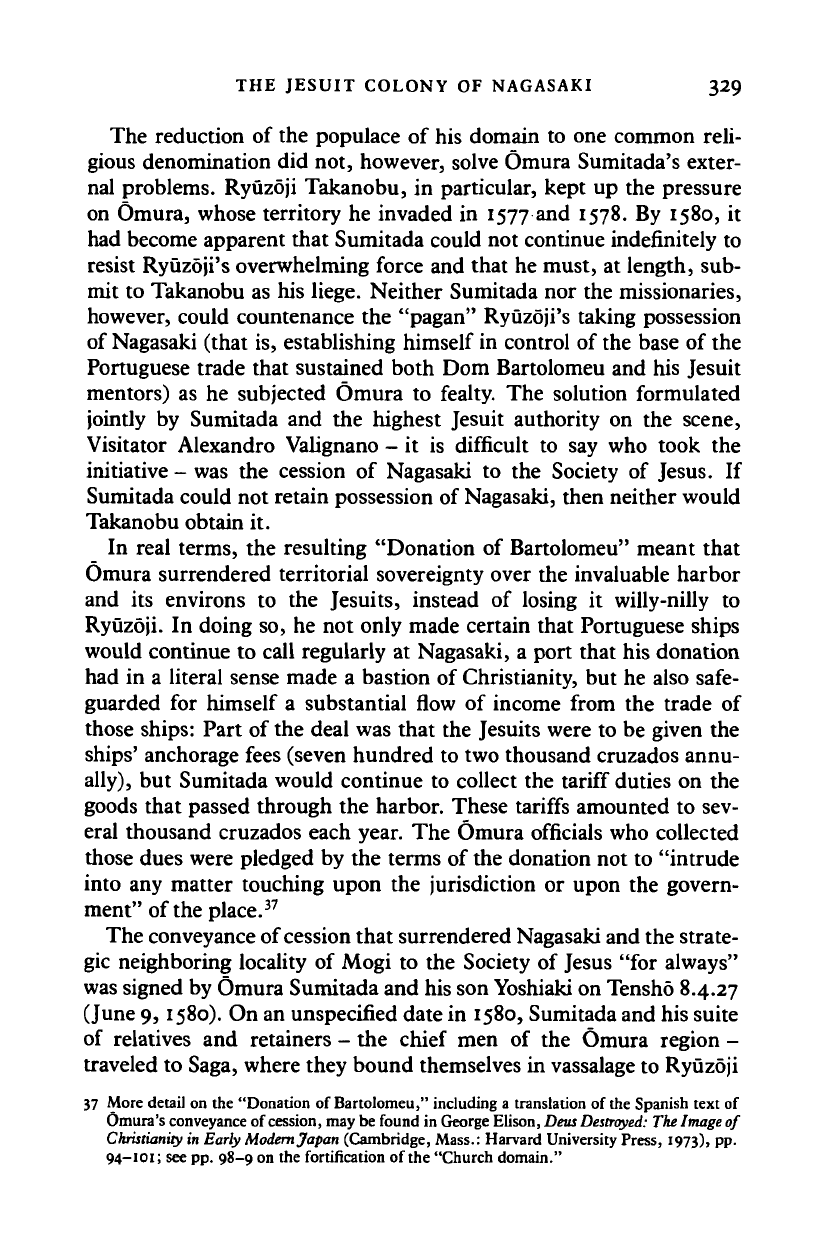
THE JESUIT COLONY OF NAGASAKI 329
The reduction of the populace of his domain to one common reli-
gious denomination did not, however, solve Omura Sumitada's exter-
nal problems. Ryuzoji Takanobu, in particular, kept up the pressure
on Omura, whose territory he invaded in 1577 and 1578. By 1580, it
had become apparent that Sumitada could not continue indefinitely to
resist Ryuzoji's overwhelming force and that he must, at length, sub-
mit to Takanobu as his liege. Neither Sumitada nor the missionaries,
however, could countenance the "pagan" Ryuzoji's taking possession
of Nagasaki (that is, establishing himself in control of the base of the
Portuguese trade that sustained both Dom Bartolomeu and his Jesuit
mentors) as he subjected Omura to fealty. The solution formulated
jointly by Sumitada and the highest Jesuit authority on the scene,
Visitator Alexandro Valignano - it is difficult to say who took the
initiative - was the cession of Nagasaki to the Society of Jesus. If
Sumitada could not retain possession of Nagasaki, then neither would
Takanobu obtain it.
In real terms, the resulting "Donation of Bartolomeu" meant that
Omura surrendered territorial sovereignty over the invaluable harbor
and its environs to the Jesuits, instead of losing it willy-nilly to
Ryuzoji. In doing so, he not only made certain that Portuguese ships
would continue to call regularly at Nagasaki, a port that his donation
had in a literal sense made a bastion of Christianity, but he also safe-
guarded for himself a substantial flow of income from the trade of
those ships: Part of the deal was that the Jesuits were to be given the
ships'
anchorage fees (seven hundred to two thousand cruzados annu-
ally),
but Sumitada would continue to collect the tariff duties on the
goods that passed through the harbor. These tariffs amounted to sev-
eral thousand cruzados each year. The Omura officials who collected
those dues were pledged by the terms of the donation not to "intrude
into any matter touching upon the jurisdiction or upon the govern-
ment" of the place.
37
The conveyance of cession that surrendered Nagasaki and the strate-
gic neighboring locality of Mogi to the Society of Jesus "for always"
was signed by Omura Sumitada and his son Yoshiaki on Tensho
8.4.27
(June 9,1580). On an unspecified date in 1580, Sumitada and his suite
of relatives and retainers - the chief men of the Omura region -
traveled to Saga, where they bound themselves in vassalage to Ryuzoji
37 More detail on the "Donation of Bartolomeu," including a translation of the Spanish text of
Omura's conveyance of cession, may be found in George Elison, Deus
Destroyed:
The Image of
Christianity in Early Modem Japan (Cambridge, Mass.: Harvard University Press, 1973), pp.
94-101;
see pp. 98-9 on the fortification of the "Church domain."
Cambridge Histories Online © Cambridge University Press, 2008
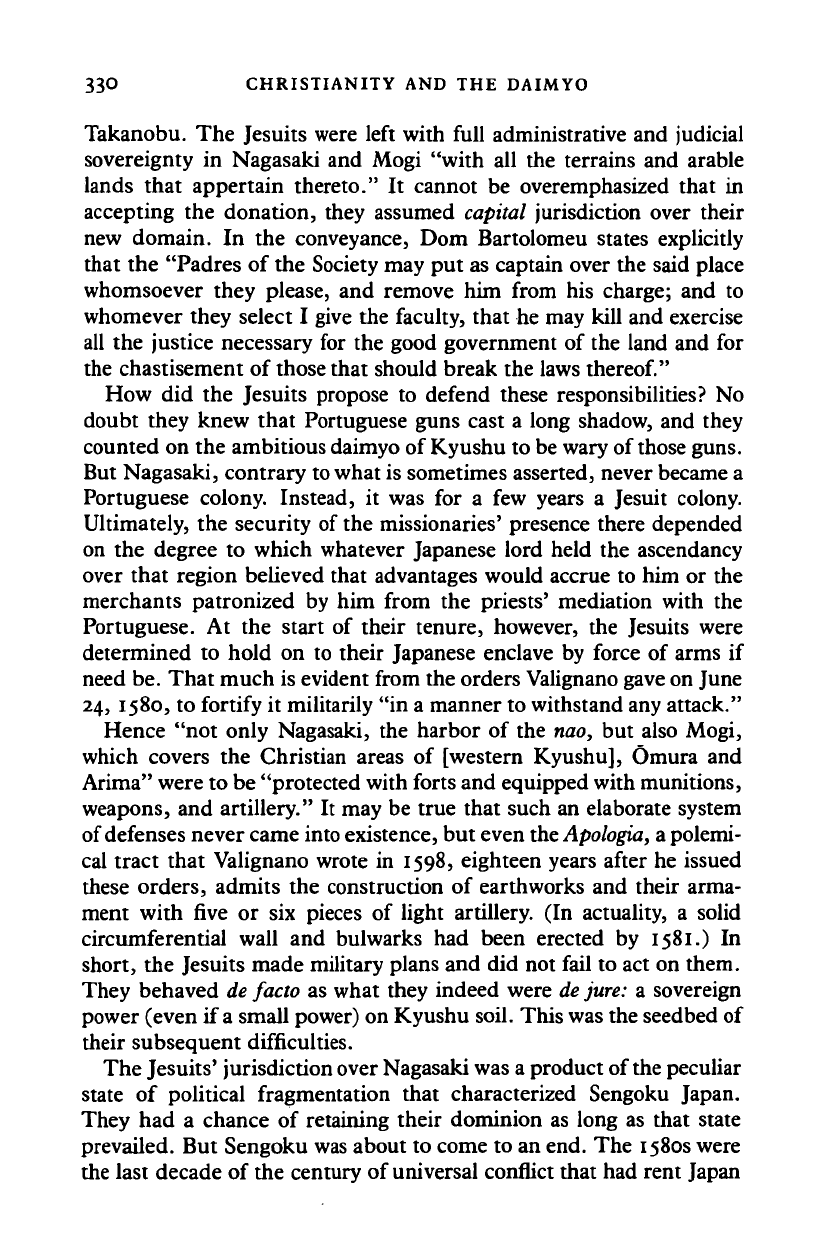
33O CHRISTIANITY AND THE DAIMYO
Takanobu. The Jesuits were left with full administrative and judicial
sovereignty in Nagasaki and Mogi "with all the terrains and arable
lands that appertain thereto." It cannot be overemphasized that in
accepting the donation, they assumed capital jurisdiction over their
new domain. In the conveyance, Dom Bartolomeu states explicitly
that the "Padres of the Society may put as captain over the said place
whomsoever they please, and remove him from his charge; and to
whomever they select I give the faculty, that he may kill and exercise
all the justice necessary for the good government of the land and for
the chastisement of those that should break the laws
thereof."
How did the Jesuits propose to defend these responsibilities? No
doubt they knew that Portuguese guns cast a long shadow, and they
counted on the ambitious daimyo of Kyushu to be wary of
those
guns.
But Nagasaki, contrary to what is sometimes asserted, never became a
Portuguese colony. Instead, it was for a few years a Jesuit colony.
Ultimately, the security of the missionaries' presence there depended
on the degree to which whatever Japanese lord held the ascendancy
over that region believed that advantages would accrue to him or the
merchants patronized by him from the priests' mediation with the
Portuguese. At the start of their tenure, however, the Jesuits were
determined to hold on to their Japanese enclave by force of arms if
need be. That much is evident from the orders Valignano gave on June
24,
1580, to fortify it militarily "in a manner to withstand any attack."
Hence "not only Nagasaki, the harbor of the nao, but also Mogi,
which covers the Christian areas of [western Kyushu], Omura and
Arima" were to be "protected with forts and equipped with munitions,
weapons, and artillery." It may be true that such an elaborate system
of defenses never came into existence, but even
the
Apologia,
a
polemi-
cal tract that Valignano wrote in 1598, eighteen years after he issued
these orders, admits the construction of earthworks and their arma-
ment with five or six pieces of light artillery. (In actuality, a solid
circumferential wall and bulwarks had been erected by 1581.) In
short, the Jesuits made military plans and did not fail to act on them.
They behaved
de
facto as what they indeed were
de
jure:
a sovereign
power (even if
a
small power) on Kyushu soil. This was the seedbed of
their subsequent difficulties.
The Jesuits' jurisdiction over Nagasaki was a product of the peculiar
state of political fragmentation that characterized Sengoku Japan.
They had a chance of retaining their dominion as long as that state
prevailed. But Sengoku was about to come to an end. The 1580s were
the last decade of the century of universal conflict that had rent Japan
Cambridge Histories Online © Cambridge University Press, 2008

CHRISTIAN ADVANCES IN KYUSHU 331
to pieces. Even as rout continued in Kyushu, regeneration was well
under way in central Japan, where the first of the great unifiers, Oda
Nobunaga (1534-82), was putting the dismembered body politic back
together by force. One of the principal items among his agenda was
the elimination of the independent religious establishments that had
developed into secular powers in the chaos of late medieval Japan.
Indeed, the subjection of religious institutions to central hegemonic
control was a major part of the general agenda of reunification.
The greatest triumph of that policy of subjugation had already been
sealed two and a half
weeks
before Omura Sumitada deeded Nagasaki
to the Jesuits: On May 22, 1580, Kennyo Kosa (1543-92), the pontiff
of the "religious monarchy" of the Honganji, the major branch of the
Buddhist True Pure Land sect (Jodo Shinshu), capitulated to Oda
Nobunaga after a sanguinary ten years' war and went into exile. A few
months later, on September 10, the great temple fortress of that sect,
the Ishiyama Honganji in Osaka, was burned, and the most prominent
Japanese symbol of the combined exercise of religious and secular
authority thereby was destroyed.
Even if Nobunaga's power never did extend to Kyushu, that of his
two great successors would. Hence it would be wise to recall that none
of
the
"Three Heroes" of Japan's reunification - Nobunaga, Toyotomi
Hideyoshi, and Tokugawa Ieyasu (1543-1616) - had any tolerance for
the type of institution that the "Church domain" of Nagasaki was.
Indeed, they all spent significant parts of their careers in fighting such
institutions.
Against that historical background, it appears entirely logical that
Hideyoshi, in the course of subjugating Kyushu to his central regime
in 1587, should have objected to the Jesuits' pretensions to authority,
their compacts with daimyo, and their forced conversions. These ob-
jections constituted the stuff of his indictment of the "Padres of the
Society" and formed the rationale for the edicts he issued banning the
missionaries. For them, the clear message of Hideyoshi's conquest of
Kyushu was this: Sengoku had come to an end, and with it, the
Jesuits' freedom of action had ended.
CHRISTIAN ADVANCES IN KYUSHU
Neither the extent to which Japan would be transformed by the Three
Heroes in the coming decades nor the dire consequences that vast
transformation would have on Japanese Christianity could be pre-
dicted by the Jesuits as they took possession of Nagasaki in 1580. They
Cambridge Histories Online © Cambridge University Press, 2008
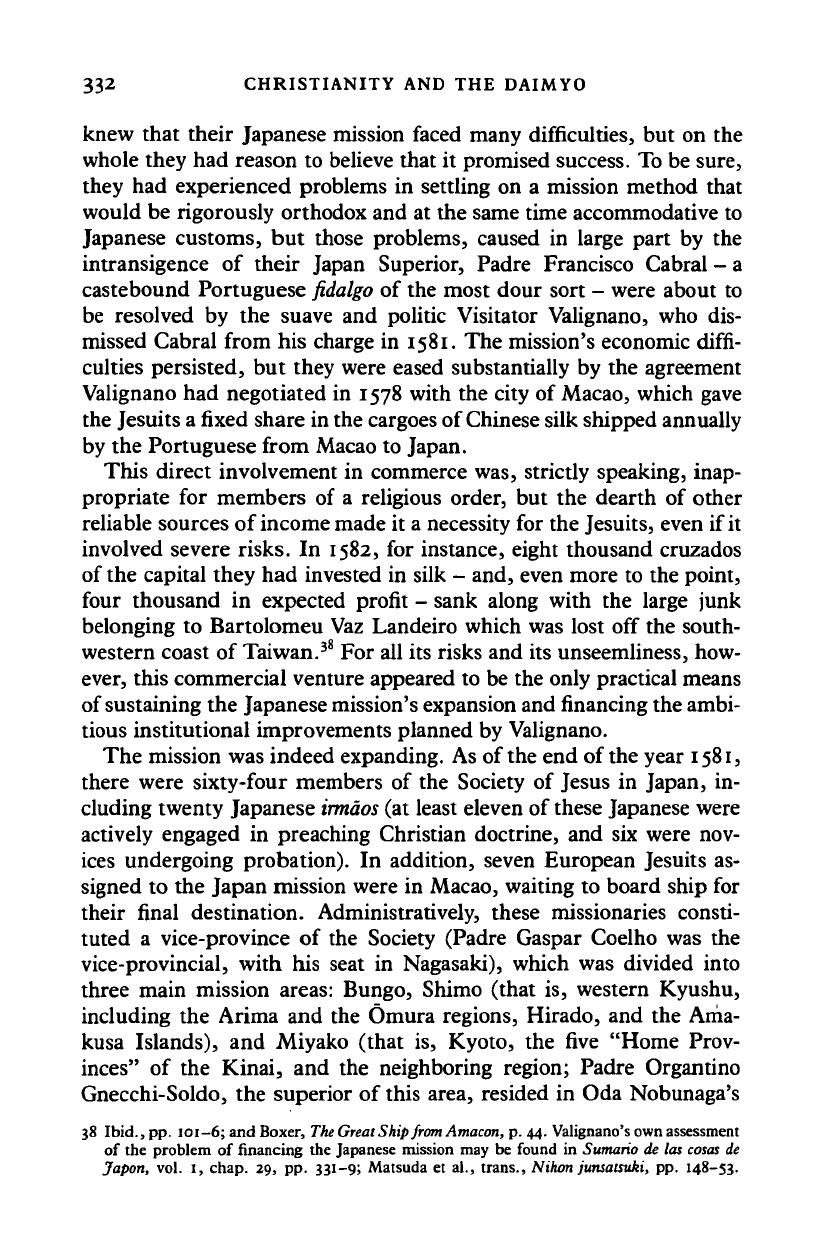
332 CHRISTIANITY AND THE DAIMYO
knew that their Japanese mission faced many difficulties, but on the
whole they had reason to believe that it promised success. To be sure,
they had experienced problems in settling on a mission method that
would be rigorously orthodox and at the same time accommodative to
Japanese customs, but those problems, caused in large part by the
intransigence of their Japan Superior, Padre Francisco Cabral - a
castebound Portuguese fidalgo of the most dour sort - were about to
be resolved by the suave and politic Visitator Valignano, who dis-
missed Cabral from his charge in 1581. The mission's economic diffi-
culties persisted, but they were eased substantially by the agreement
Valignano had negotiated in 1578 with the city of Macao, which gave
the Jesuits a fixed share in the cargoes of Chinese silk shipped annually
by the Portuguese from Macao to Japan.
This direct involvement in commerce was, strictly speaking, inap-
propriate for members of a religious order, but the dearth of other
reliable sources of income made it a necessity for the Jesuits, even if it
involved severe risks. In 1582, for instance, eight thousand cruzados
of the capital they had invested in silk - and, even more to the point,
four thousand in expected profit - sank along with the large junk
belonging to Bartolomeu Vaz Landeiro which was lost off the south-
western coast of Taiwan.
38
For all its risks and its unseemliness, how-
ever, this commercial venture appeared to be the only practical means
of sustaining the Japanese mission's expansion and financing the ambi-
tious institutional improvements planned by Valignano.
The mission was indeed expanding. As of the end of the year 1581,
there were sixty-four members of the Society of Jesus in Japan, in-
cluding twenty Japanese
irmdos
(at least eleven of these Japanese were
actively engaged in preaching Christian doctrine, and six were nov-
ices undergoing probation). In addition, seven European Jesuits as-
signed to the Japan mission were in Macao, waiting to board ship for
their final destination. Administratively, these missionaries consti-
tuted a vice-province of the Society (Padre Gaspar Coelho was the
vice-provincial, with his seat in Nagasaki), which was divided into
three main mission areas: Bungo, Shimo (that is, western Kyushu,
including the Arima and the Omura regions, Hirado, and the Ama-
kusa Islands), and Miyako (that is, Kyoto, the five "Home Prov-
inces"
of the Kinai, and the neighboring region; Padre Organtino
Gnecchi-Soldo, the superior of this area, resided in Oda Nobunaga's
38 Ibid.,pp. 101-6; and Boxer,
The
Great Ship
from
Amacon, p. 44. Valignano's own assessment
of the problem of financing the Japanese mission may be found in Sumario de las
cosas
de
Japon, vol. 1, chap. 29, pp. 331-9; Matsuda et al., trans., Nihon junsatsuki, pp. 148-53.
Cambridge Histories Online © Cambridge University Press, 2008

CHRISTIAN ADVANCES IN KYUSHU 333
castle town of Azuchi). About 150,000 Christians were under their
spiritual care.
39
A considerable boost was given the number of their converts when
Amakusa Shigehisa (baptized Miguel in
1571,
d. 1582), a baron in the
orbit of the Shimazu of Satsuma who had his main residence at
Kawachi no Ura on one of the Amakusa Islands, was persuaded in
1577
to undertake the wholesale Christianization of his subjects. In the
typical manner of such enterprises, the "bonzes" (fiozu, Buddhist
priests) of Shigehisa's domain were confronted with the choice of
either turning Christian or leaving Amakusa. Buddhist temples were
destroyed, and churches arose in their place. In quick order, all of
Dom Miguel's subjects, "ten or twelve thousand souls," submitted to
baptism.
40
An even greater advance came with the conversion of Arima
Harunobu, the lord of
the
Takaku region of
Hizen.
Harunobu's father
Yoshisada (Dom Andre, 1521-76), baptized in April 1576, had in little
more than half a year brought about the conversion of more than
twelve thousand of his subjects. After Dom Andre's death that same
December, however, there followed a persecution in Arima. His suc-
cessor Harunobu and his principal vassals "expelled the Padres,
hewed down the crosses, burned the church, and forced the Christians
of their region to apostatize."
41
But Harunobu, like his uncle Omura
Sumitada, was the target not only of internal rebellions but also of
external aggression on the part of the powerful Ryuzoji Takanobu;
hence he, too, was susceptible to the lure of military assistance. The
Jesuits appreciated and utilized that susceptibility. Indeed, when
Valignano steered the Great Ship of
1579,
a
nao
belonging to Leonel de
Brito,
to the port of Kuchinotsu in the Arima domain, he did so with
the direct intention of inducing Arima Harunobu to favor Christianity.
The Jesuit chronicler Luis Frois tells us that early in 1580, as
Arima's last forts were either in flames or under siege, Padre Alexan-
dro Valignano, eager to keep Harunobu from "despairing entirely,"
ordered that "succor be given the fortresses that were under fire."
Making sure to "provision them with victuals and some silver, as
much as he could," Valignano also supplied them with "lead and
39 On the number of Jesuits in Japan, see
Textus catalogorum
Japoniae, no. 20, pp. 120-7. On
the number of Christians, see the chart set out by Schutte in
Introductio
ad
historiam
Societatis
Jesu injaptmia, pp. 429-30.
40 Frois, Historia, pt. I, chap. 81, Wicki, vol. 2, p. 231; Matsuda and Kawasaki, trans.,
Furoisu
Nihonshi, vol. 9, p. 321.
41 Valignano to General SJ, Kuchinotsu, December 10, 1579, cited in Schutte, Valignanos
Missionsgrundsdtze,
vol. I, pt. 1, p. 401.
Cambridge Histories Online © Cambridge University Press, 2008
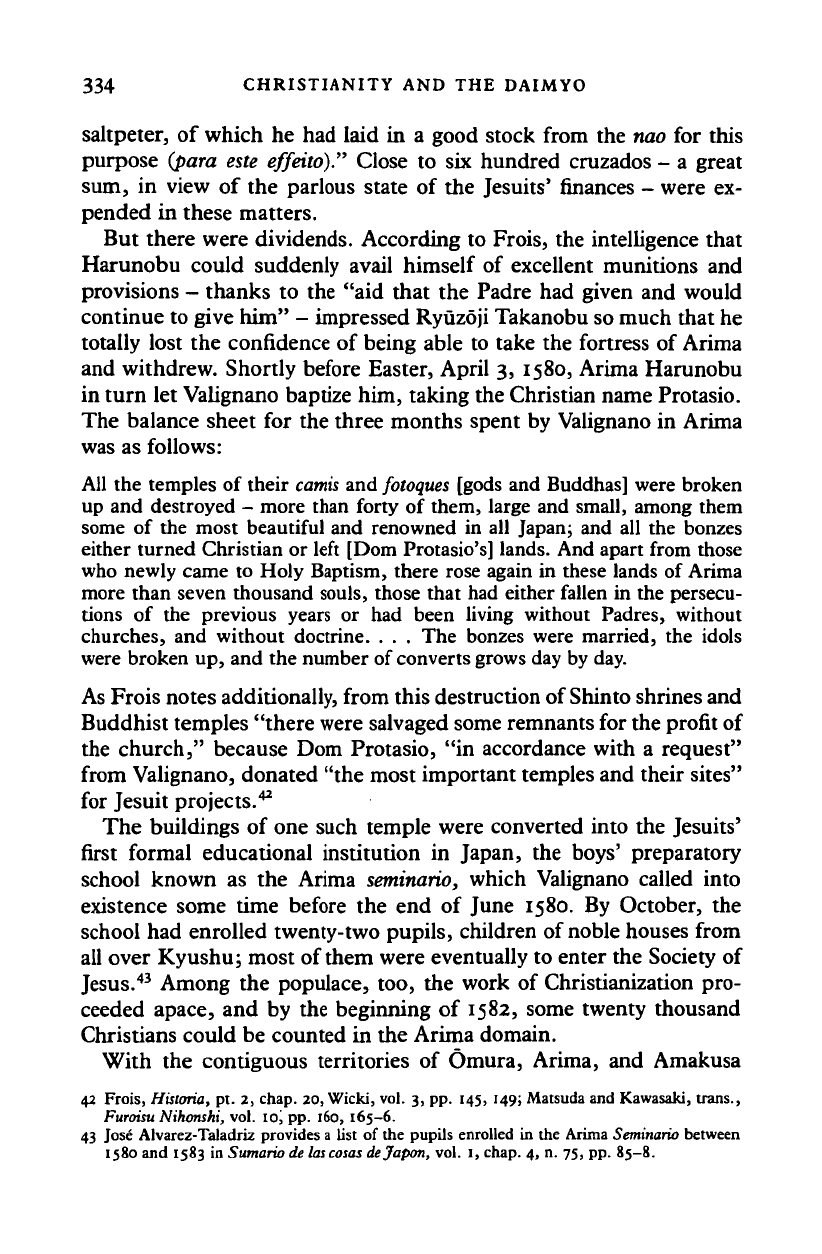
334 CHRISTIANITY AND THE DAIMYO
saltpeter, of which he had laid in a good stock from the nao for this
purpose (para este effeito)." Close to six hundred cruzados - a great
sum, in view of the parlous state of the Jesuits' finances - were ex-
pended in these matters.
But there were dividends. According to Frois, the intelligence that
Harunobu could suddenly avail himself of excellent munitions and
provisions - thanks to the "aid that the Padre had given and would
continue to give him" - impressed Ryuzoji Takanobu so much that he
totally lost the confidence of being able to take the fortress of Arima
and withdrew. Shortly before Easter, April 3, 1580, Arima Harunobu
in turn let Vahgnano baptize him, taking the Christian name Protasio.
The balance sheet for the three months spent by Valignano in Arima
was as follows:
All the temples of their
camis
and
fotoques
[gods and Buddhas] were broken
up and destroyed
—
more than forty of them, large and small, among them
some of the most beautiful and renowned in all Japan; and all the bonzes
either turned Christian or left [Dom Protasio's] lands. And apart from those
who newly came to Holy Baptism, there rose again in these lands of Arima
more than seven thousand souls, those that had either fallen in the persecu-
tions of the previous years or had been living without Padres, without
churches, and without doctrine. . . . The bonzes were married, the idols
were broken up, and the number of converts grows day by day.
As Frois notes additionally, from this destruction of Shinto shrines and
Buddhist temples "there were salvaged some remnants for the profit of
the church," because Dom Protasio, "in accordance with a request"
from Valignano, donated "the most important temples and their sites"
for Jesuit projects.
42
The buildings of one such temple were converted into the Jesuits'
first formal educational institution in Japan, the boys' preparatory
school known as the Arima seminario, which Valignano called into
existence some time before the end of June 1580. By October, the
school had enrolled twenty-two pupils, children of noble houses from
all over Kyushu; most of them were eventually to enter the Society of
Jesus.
43
Among the populace, too, the work of Christianization pro-
ceeded apace, and by the beginning of 1582, some twenty thousand
Christians could be counted in the Arima domain.
With the contiguous territories of Omura, Arima, and Amakusa
42 Frois, Historia, pt. 2, chap. 20, Wicki, vol. 3, pp. 145, 149; Matsuda and Kawasaki, trans.,
Furoisu Nihonshi, vol. ioi pp. 160, 165-6.
43 Jose Alvarez-Taladriz provides a list of the pupils enrolled in the Arima Seminario between
1580 and 1583 in Sumario de lascosas dejapon, vol. i,chap. 4, n. 75, pp. 85-8.
Cambridge Histories Online © Cambridge University Press, 2008
